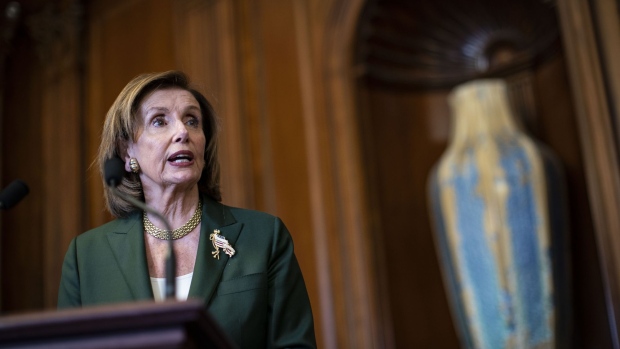Aug 23, 2021
Biden’s Agenda Turns on Pelosi Keeping House Democrats United
, Bloomberg News

(Bloomberg) -- President Joe Biden’s $4.1 trillion economic agenda, after early progress in the Senate, now faces a crucial test this week in the U.S. House, where Speaker Nancy Pelosi must keep her fractious Democratic majority moving in lockstep.
Biden’s plan has momentum in the Senate. But the House votes have Pelosi fighting to keep tension between progressives and centrists among her narrow majority from derailing the strategy that she, Biden and Senate Majority Leader Chuck Schumer have crafted for moving the president’s two-part project through Congress.
Pelosi emphasized the stakes in an open letter to fellow House Democrats over the weekend after conferring with Biden.
“It is essential that our caucus proceeds unified in our determination to deliver once-in-a-century progress for the children,” she wrote.
On Monday, the House is set to take a procedural vote on rules for debate on three measures: a $3.5 trillion budget resolution that sets up work on a Democrats-only package of social spending and tax increases; the $550 billion bipartisan infrastructure bill that passed the Senate; and a separate voting-rights measure.
Pelosi’s plan then would have the House adopt the budget resolution and pass the voting-rights legislation on Tuesday, but leave the infrastructure bill until the Senate completes the $3.5 trillion spending package outlined by the resolution later in the year.
Delaying House passage of the infrastructure legislation keeps Pelosi’s commitment to progressives, who want to hold on to the bill as leverage to ensure the Senate addresses their priorities on social programs and climate policy in the spending package.
But it’s sparked a rebellion by a group of nine moderates, led by New Jersey Representative Josh Gottheimer, who threatened in an Aug. 12 letter to Pelosi to withhold support for the budget resolution until the House passed the infrastructure bill and sent it to Biden for his signature.
While there is some GOP support for the infrastructure legislation, which easily passed the Senate on Aug. 10, House Republicans are expected to vote en masse against the budget resolution. With a 220 to 212 majority, Pelosi can afford no more than three Democratic defections.
“Any delay to passing the budget resolution threatens the timetable for delivering the historic progress and the transformative vision that Democrats share,” Pelosi wrote in her letter. She set a deadline to pass the spending measure and the infrastructure bill by Oct. 1.
Pelosi and the White House have kept up a pressure campaign to keep the strategy on track. Brian Deese, Biden’s director of the National Economic Council, Labor Secretary Marty Walsh and Energy Secretary Jennifer Granholm were among the administration officials who leaned on the moderates and others.
Biden held a virtual meeting with House Democratic leaders and key committee chairs last week to emphasize they were united on the strategy for moving forward with his agenda. On Saturday, the White House released a statement reiterating Biden’s support for Pelosi’s plan to move on the budget resolution.
Pelosi also reached into her legislative bag of tricks by wrapping the voting rights legislation -- which most Democrats back -- into Monday’s procedural vote to advance the budget resolution and the infrastructure. That means they all have to either advance, or fail, together, raising the political risks for the moderate group.
The moderates on Friday reiterated their stance that the House should pass the infrastructure bill now. But their statements didn’t include previous threats to withhold support for the budget resolution.
“I believe we should first vote immediately on the bipartisan infrastructure package, send it to the President’s desk, and then quickly consider the budget resolution, which I plan to support,” Gottheimer said in a statement.
Forcing Cooperation
Josh Huder, a senior fellow at Georgetown University’s Government Affairs Institute, said that while Pelosi faces real challenges in getting Biden’s agenda through the House, the divisions among Democrats also give her some significant leverage.
“Every faction in the Democratic caucus wants something from the deal. Moderates want infrastructure. Progressives want a lot of things,” said Huder. “The only way either group achieves their goals is by helping the other wing of the caucus. This situation is about as good as it gets in terms of caucus management.”
Biden and the Democrats still face challenges ahead in the Senate.
Twelve Senate committees are already at work trying to craft portions of the spending package that will fill in the details of the budget resolution on climate change, tax hikes on corporations and the wealthy, tuition-free community college, a Medicare expansion and more.
They are using a process called reconciliation that will allow them to pass the expansive economic agenda on their own. But it’s not clear that every Democrat is on board with the $3.5 trillion size of the plan, even though they all voted for the fiscal framework in early August.
Some, like Kyrsten Sinema of Arizona and Joe Manchin of West Virginia, are balking at the price tag or the size of the tax hikes Biden has proposed to help pay for it. Manchin has also said he disagrees with Democrats who want to target fossil fuels, setting up tension for a key piece of the legislation.
Other intra-party fissures could emerge as the details become clear, and if the Senate parliamentarian effectively jettisons any portions that can’t meet strict rules to avoid a GOP filibuster.
Meanwhile the infrastructure debate may not be over in the Senate, despite bipartisan support for the $550 billion package that cleared the chamber on Aug. 10 on a 69-30 vote. If the House makes any changes, those will have to be negotiated and clear the Senate. Some progressive House Democrats are pushing for a larger package, but going too far risks more Senate GOP defections over the deficit impact.
©2021 Bloomberg L.P.







